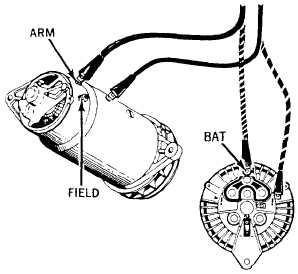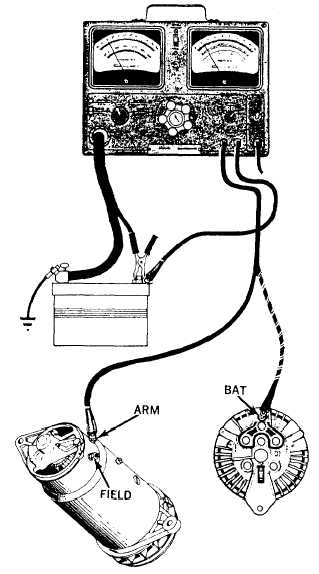resistance in these circuits reduces the overall charge rate and leads to eventual battery discharge.
The external volts lead is connected to the generator armature terminal, as shown in figure 4-11, when a generator is tested and to the battery terminal when an alternator is tested.
If a voltage loss exceeds the specified amount for the unit being tested, an excessive resistance is present within the charging system; that is, within the wiring harness, connections, regulator, and vehicle ammeter (if used). The excessive resistance might take the form of LOOSE or CORRODED CONNECTIONS at the output terminal of the generator or alternator, the armature terminal of the regulator, or the back of the ammeter or battery terminal of the starter solenoid battery cable connections. Excessive resistance can also be due to faulty wiring from generator to regulator, regulator to ammeter, or ammeter to starter solenoid; to burned or oxidized cutout relay contacts within the regulator; or to poor electrical connections between the generator or alternator and the engine. To isolate the point of excessive resistance, conduct a charging system insulated circuit resistance test. generator armature terminal or to the battery terminal. (See fig. 4-12.) Remember to reverse the external volts lead for positive ground systems. Start the engine and adjust its speed to approximately 2,000 rpm. Then adjust the load increase knob until the AMMETER scale indicates a current of 20 amperes for dc systems or 10 amperes for ac systems. Also observe the voltage reading on the (3-volt) VOLTMETER scale and compare it with the specifications for proper charging system operation, as required by the vehicle manufacturer. If the reading is within specification, you should proceed with a charging system ground circuit resistance test.
CHARGING SYSTEM INSULATED CIRCUIT RESISTANCE TEST
You can conduct a charging system insulated circuit resistance test by setting the volt range selector knob to the -0.3 to 3.0 volt scale position. When you test an alternator, observe the polarity, and connect the external volts lead to the

Figure 4-11.-Circuit resistance test.

Figure 4-12.-Insulated circuit resistance test.
Continue Reading